Friends of the Hollywood Central Park Board of Directors
FHCP Staff
-
Philip E. Aarons, Chairman
-
Alfred Fraijo, Jr., President
-
George Abou-Daoud, Vice President
-
Jeffrey Briggs, Vice President
-
Brian Folb, Vice President
-
Scott Campbell, Treasurer
-
Christi Van Cleve, Secretary
-
Christopher Barton
-
George Brauckman
-
Douglas Campbell
-
Heather Cochran
-
James Feldman
-
Kate Folb
-
Betty Fraser
-
Craig Fry
-
David Gajda
-
Cheryl Gaskill
-
Terri Gerger
-
Aileen Getty
-
Bradley Glenn
-
John Goodwin
-
Phil Hart, PhD
-
Ed V. Hunt
-
Tricia LaBelle
-
Jacob Lipa
-
Jerold B. Neuman
-
Susan Polifronio
-
Scott Rynders
-
Nicole Shahenian
-
Sam Smith
-
Thaddeus Hunter Smith
-
Robert Soderstrom
-
Gary Taglyan
-
Todd Warner
-
Laurie Goldman
Executive Director
-
Alfredo Hernandez
Program Director
I ♥ Hollywood Central Park
Show your support for your Hollywood Central Park Give us a positive review at: Great Non-Profits
|
 |
In this issue:
A Message from the President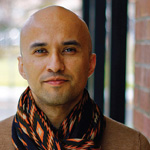
Recently I toured the “Becoming Los Angeles” exhibition at the Natural History Museum of Los Angeles County. I was dazzled by so many revelations regarding the growth of our City.
Laurie Goldman, FHCP Executive Director
It was a blistering cold spring day in March with ice on the ground when the intrepid group of FHCP delegates experienced first-hand the glory that is Millennium Park, one of the largest “green roofs” in the world.
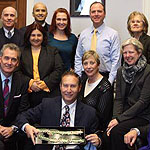
As a long-time supporter and friend of the Hollywood Central Park, I am pleased to share that the project has been making great strides and also gaining new fans both in Los Angeles and even our nation's Capitol. I am proud to represent the vibrant Hollywood community, and to partner with our local and federal leaders to make Hollywood Central Park a reality.
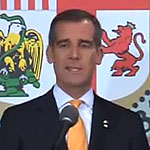 Alfredo A. Hernandez, FHCP Program Director Alfredo A. Hernandez, FHCP Program Director
At Mayor Garcetti’s State of the City address on April 10, he spoke about his back to basics approach for running the city.
Bold Moves
A Message from the President
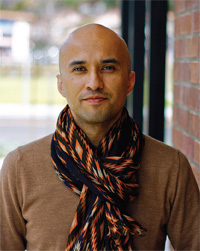 Los Angeles was built on bold moves. Los Angeles was built on bold moves.
Recently I toured the “Becoming Los Angeles” exhibition at the Natural History Museum of Los Angeles County. I was dazzled by so many revelations regarding the growth of our City. Walking through the exhibition rooms, a common theme emerged concerning the formation of our City. From the development of the early settlements to the construction of the aqueduct to the expansion of the railroads out to the coast, the City we love today was built on a passion for reinvention and experimentation. It required a spirit of adventure and a grand vision. Otherwise, who could imagine a great city in the middle of a desert?
I think Howard Zinn once wrote that the power of a bold idea cannot be measured. Today, the City depends more than ever on bold ideas and moves to ensure its future is bright. I think of it as a bright green. Like the color of trees in the Spring. Seriously speaking, what I mean is that the way we address environmental justice issues in Los Angeles today will be how historians measure the success of our own times tomorrow. More than ever, we are being tested as a City in our ability to provide cleaner area, cleaner water and greener, more accessible open space to all our citizens.
We should honor our forbearers with a new set of bold inventions to respond to the environmental needs of Los Angeles. We need more green infrastructure. Our beloved Hollywood Central Park is a project with the needed environmental benefits – 44 acres of green space in the neediest area of the City, the creation of thousands of jobs during and after construction, the planting of thousands of noise-buffering and pollution-hungry trees, new habitat for birds and other animals, and new playgrounds (not PlayStations) for kids all over Los Angeles. Can you imagine the possibilities?
I can. I think of the enormous mental and health benefits for our kids. Countless studies show that proximity to open space lifts the spirit, reduces stress, and improves a range of health indicators. I imagine healthier, happier families in Los Angeles.
Our Hollywood Central Park will transform our City as did the development of the aqueduct or any other major project in our history.
To be bold is to rise up to the occasion. It means meeting a great need with a great solution and the courage to see it through. We need more urban parkland for the park starved with a great project worthy of the spirit of Los Angeles. Stand with us.
Alfred Fraijo, Jr.
President
The Windy City Is Might Purty
Laurie Goldman, FHCP Executive Director
Millennium Park, Chicago
I just blew in from the windy city
The windy city is mighty purty
But they ain't got what we got, no sirree
Windy City performed by Doris Day in the feature film, Calamity Jane
It was a blistering cold spring day in March with ice on the ground when the intrepid group of FHCP delegates experienced first-hand the glory that is Millennium Park, one of the largest “green roofs” in the world. Led by Millennium Park Foundation Executive Director, Edward Uhlir, the delegates toured every inch of Millennium Park and learned the ins and outs of their phenomenal success.
There is so much to share with you; it is hard to know where to begin. What we noticed first was how this 24.5 acre park fits in beautifully within its surrounding area. It feels as if Millennium Park was always there as part of the fabric of Chicago (when we know it was just a rail yard 15 years ago!). Is this the result of the innovative planning, design and execution or the intense landscaping or the extraordinary art and sculpture? Millennium Park is organic and natural in its home, as if the City grew around the Park instead of the other way around. A masterful achievement!
Odd as it may sound, MP was first built without a plan and was later re-built to accommodate Frank Gehry’s exceptional design of the Jay Pritzker Pavilion, which by the way is considered a “sculpture” and not a structure. It seems that when the federal government donated the air space above the rail yard to the City of Chicago there were two requirements: all programming would be free to the public and no structures could be built in the Park, hence all structures are “sculptures”. The Park Grill Restaurant was built approximately 2 feet below Park level to accommodate this requirement. Another oddity which is completely foreign to Californians is the fact that MP was built with no federal environmental documents. Building a 24.5 acre Millennium Park in the middle of downtown Chicago without environmental documents clearly had its advantages for the City of Chicago.
Although the calendar had moved into spring, due to the extreme harsh winter weather, the 550 trees and Lurie Gardens were dormant. With just a bit of imagination, however, you could “see” the enduring beauty of Millennium Park in full bloom. It’s such a pretty park made all the more splendid by the sun; the play of light dances throughout and provides interesting shapes and environments in which to enjoy every aspect of the Park. And then there is Cloud Gate, aka the Bean, designed by Anish Kapoor. Not only is the Bean an instrument of light, reflection and perspective, it’s a magnificent sculpture representative of all that is Chicago. Chicagoans and tourists alike can’t seem to get enough of the Bean, nor could we. We spent at least an hour taking photos and playing under the “navel” known for its distortive qualities; how better to rekindle the child in all of us?
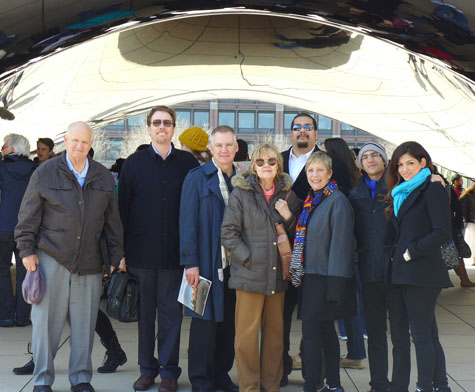
Cloud Gate, l-r Ed V. Hunt, Jason Brandman, Scott Campbell, Martha Hunt, Alfredo Hernandez, Gary Taglyan and Stella Kirakoysan
The snakelike BP Pedestrian Bridge designed by Frank Gehry is a connecting link from Millennium Park to the lakefront, other parts of Grant Park and the parking garage but also provides a barrier for traffic noises. The bridge provided the delegates with breathtaking views of Chicago and a final look back at the distinctive charm of Millennium Park. The bridge is wide and curvy offering new perspectives of Millennium Park at every turn. From any vantage point along its 935 feet, we were reminded of the ability of parks to enhance our quality of life and to transform our environment for the better. (Due to the construction of the neighboring recreational Maggie Daley Park the bridge is closed at its midpoint.)
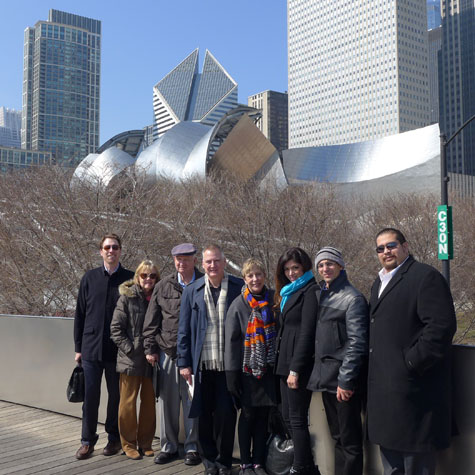
BP Pedestrian Bridge designed by Frank Gehry, l-r Jason Brandman, Martha Hunt, Ed V. Hunt, Scott Campbell, Laurie Goldman, Stella Kirakoysan, Gary Taglyan and Alfredo Hernandez
Millennium Park was funded by an unprecedented public-private partnership. Major corporations and family foundations inspired by Mayor Daley’s visionary idea for new public space, contributed the construction funds for the various unique spaces and sculptures/structures which bear their names. With the commitment from the private sector, this funding model serves as a valuable template for building parks across the country and is proof positive that parks are an integral part of livable and sustainable cities.
It is not an exaggeration to say that we found it difficult to leave Millennium Park because it is a comfortable space -a nurturing space - a lovely space. We pledged to return in warmer weather.
Chicago is mighty purty but they ain’t got we got, no sirree! And what we’ve got is beautiful weather nearly 365 days a year – the perfect weather for a Park!
About Millennium Park:
-
Covered with unsightly railroad tracks and parking lots this area was blight on Chicago’s lakefront throughout the 20th Century. An industrial wasteland, once controlled by the Illinois Central Railroad has been transformed into a visionary world-class 24.5 acre public park. As of 2009, Millennium Park trailed only Navy Pier as a Chicago tourist attraction.
-
Millennium Park was first conceived in late 1997 with Mayor Richard M. Daley’s vision of turning the area into a new public space for residents of Chicago. The original plan called for a 16-acre park and outdoor music venue in the traditional Beaux Arts style of Grant Park. Over time, with the commitment of the private sector and the involvement of world-renowned architect Frank Gehry, the project evolved into an ambitious undertaking featuring a collection of world-renowned artists, architects, planners, landscape architects and designers.
-
Millennium Park, a portion of the 319 acre Grant Park, is known as the “front lawn” of downtown Chicago. An Arts and Culture Park, Millennium Park has four major artistic highlights, Cloud Gate, Crown Fountain, Lurie Garden and the Jay Pritzker Pavilion. Other features include the Joan W. and Irving B. Harris Theatre for Music and Dance, the McDonald’s Cycle Center, the AT&T Plaza, Wrigley Square, the McCormick Tribute Ice Skating Rink, the Exelon Pavilions and by far our favorite structure/sculpture, the BP Pedestrian Bridge designed by Frank Gehry.
-
Attracts approximately 5 million visitors annually, a 60% increase in a 6-year period, and generates an estimated annual revenue of $1.4 billion in direct visitor spending and an additional $78 million in tax revenue.
-
Removes 426.9 lbs. of air pollutants each year through the addition of 550 trees
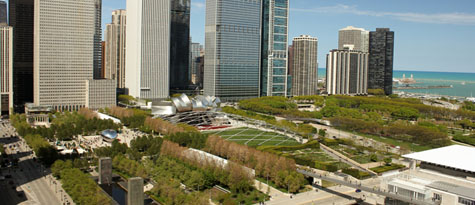
In Millennium Park, you’ll find a new kind of town square – a lively, spectacular gathering spot located in the heart of the city and a destination for Chicagoans and visitors alike. From Millennium Park Website.
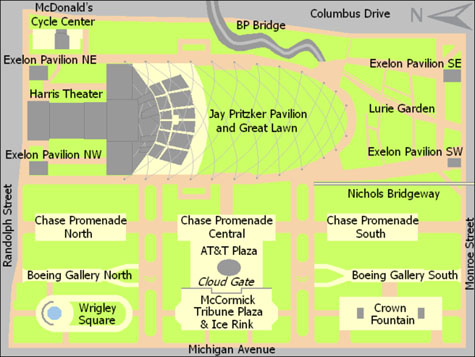
Map of Millennium Park
An Update From Congressman Adam B. Schiff
Dear Friends:
As a long-time supporter and friend of the Hollywood Central Park, I am pleased to share that the project has been making great strides and also gaining new fans both in Los Angeles and even our nation's Capitol. I am proud to represent the vibrant Hollywood community, and to partner with our local and federal leaders to make Hollywood Central Park a reality.
It was such a pleasure to meet with over twenty board members and supporters of the Friends of the Hollywood Central Park (FHCP) in Washington last month. FHCP was visiting as part of its annual advocacy trip to educate Congressional leaders and Administration officials about the many benefits of building a cap park over the Hollywood Freeway.
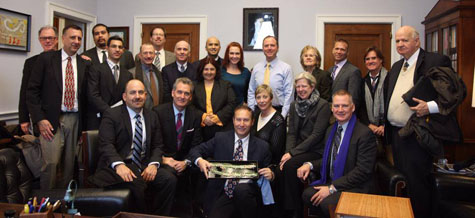
Standing back row l-r, Doug Campbell, Alfredo Hernandez, Jason Brandman and Alfred Fraijo. Standing l-r, Dave Gajda, Gary Taglyan, Brian Folb, Jacob Lipa, Nicole Shahenian, Amy Yeager, Congressman Adam Schiff, Martha Hunt, Todd Warner, Thaddeus Hunter Smith and Ed V. Hunt. Seated l-r, Michael LoGrande, John Goodwin, Jose Malagon, Laurie Goldman, Christi Van Cleve and Scott Campbell.
Many of our federal transportation programs were established when the predominate investment was in highway construction and road-building. The goal of course was interconnectivity but it came with a high cost: roads bisected our communities, freeways turned our natural landscapes into a concrete jungles, and the focus on one mode of transportation fueled our dependence on cars. As the country and our region look for creative ways to reclaim green space and turn concrete jungles into open spaces the entire community can utilize and enjoy, FHCP shared their vision for a greener, cleaner, and healthier Los Angeles, and urged policymakers and the Administration to make this part of transportation planning’s new reality.
One of the highlights of the advocacy trip was a meeting at U.S. Department of Transportation (DOT) headquarters with Acting Deputy Secretary Victor Mendez. It was inspiring to join the FHCP Board, led by the ever-energetic Executive Director Laurie Goldman, speak of the environmental, societal, and economic benefits of the park. The energy was contagious and Deputy Secretary Mendez was soon enthusiastically engaged and helping the group brainstorm potential sources of federal resources. Dialogue between U.S. DOT and FHCP has continued, and with Hollywood’s recent federal designation as one of the first five “Promise Zones” in the country, our community is expected to receive concentrated public and private investments to boost economic activity.
I am inspired and excited to be part of the Park’s journey, and I can’t wait to see where we go from here!
In solidarity,
Adam B. Schiff
Member of Congress (CA-28)
Mayor Garcetti's Back to Basics Agenda
Alfredo A. Hernandez, FHCP Program Director
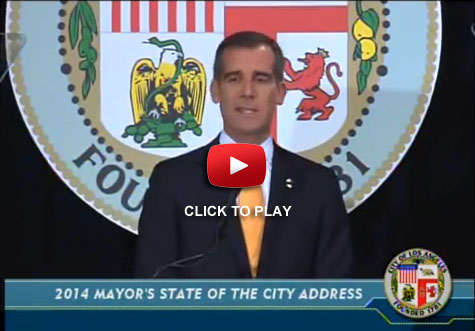
At Mayor Garcetti’s State of the City address on April 10, he spoke about his back to basics approach for running the city. Friends of the Hollywood Central Park supports Mayor Garcetti and this back to basics approach and believes that urban parks are a basic quality of life need for disadvantaged communities found in Hollywood. Please join us in writing to Mayor Eric Garcetti to encourage him to place the Hollywood Central Park at the forefront of his back to basics agenda by clicking here.
|

